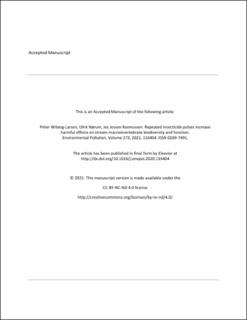| dc.contributor.author | Wiberg-Larsen, Peter | |
| dc.contributor.author | Nørum, Ulrik | |
| dc.contributor.author | Rasmussen, Jes Jessen | |
| dc.date.accessioned | 2021-07-13T13:32:13Z | |
| dc.date.available | 2021-07-13T13:32:13Z | |
| dc.date.created | 2021-03-16T12:37:19Z | |
| dc.date.issued | 2021 | |
| dc.identifier.citation | Environmental Pollution (1987). 2021, 273, 116404 . | en_US |
| dc.identifier.issn | 0269-7491 | |
| dc.identifier.uri | https://hdl.handle.net/11250/2764308 | |
| dc.description | Embargo until 29 December 2022. | en_US |
| dc.description.abstract | We exposed twelve mesocosm stream channels and four instream channels to one, two, and four pulses of the insecticide lambda-cyhalothrin (0.1 μg L−1) applied at two day intervals, each pulse lasting 90 min. Unexposed controls were included. We monitored macroinvertebrate taxonomic composition in the channels and in deployed leaf packs one day before and 29 days after the first exposure. Further, we measured drift in and out of the channels and leaf litter decomposition. Lambda-cyhalothrin exposures induced significantly increased drift in both experiments especially for Gammarus pulex, Amphinemura standfussi, and Leuctra spp. Macroinvertebrate taxonomic composition increasingly changed with increasing number of lambda-cyhalothrin exposures being most pronounced in the mesocosm channels. Further, leaf decomposition significantly decreased with increasing number of exposures in the mesocosm channels. Our study showed that species with predicted highest sensitivity to lambda-cyhalothrin were primary drivers of significant changes in taxonomic composition lasting for at least one month despite continuous recolonization of exposed channels from upstream parts of the natural stream and from the water inlet in the mesocosm channels. The overall results highlight the importance of sequential exposures to insecticides for understanding the full impact of insecticides on macroinvertebrates at the community level in streams. | en_US |
| dc.language.iso | eng | en_US |
| dc.publisher | Elsevier | en_US |
| dc.rights | Attribution-NonCommercial-NoDerivatives 4.0 Internasjonal | * |
| dc.rights.uri | http://creativecommons.org/licenses/by-nc-nd/4.0/deed.no | * |
| dc.title | Repeated insecticide pulses increase harmful effects on stream macroinvertebrate biodiversity and function | en_US |
| dc.type | Peer reviewed | en_US |
| dc.type | Journal article | en_US |
| dc.description.version | acceptedVersion | en_US |
| dc.source.pagenumber | 8 | en_US |
| dc.source.volume | 273 | en_US |
| dc.source.journal | Environmental Pollution (1987) | en_US |
| dc.identifier.doi | 10.1016/j.envpol.2020.116404 | |
| dc.identifier.cristin | 1898322 | |
| dc.source.articlenumber | 116404 | en_US |
| cristin.ispublished | true | |
| cristin.fulltext | postprint | |
| cristin.qualitycode | 1 | |

